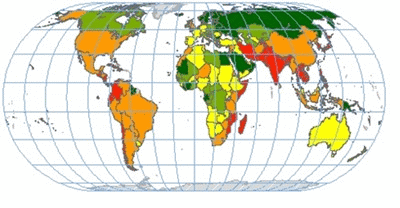Climate-Related Hazards: A Method for Global Assessment of Urban and Rural Population Exposure to Cyclones, Droughts, and Floods
Abstract
:1. Introduction
1.1. Previous Exposure Assessments
1.2. Objectives
2. Methods and Materials
2.1. Data Sources and Approach
2.2. Population Density
| Dataset | Spatial Resolution | Years | Census Input Data | Ancillary Variables | Interpolation Method | Source |
|---|---|---|---|---|---|---|
| GPW v3 | 2.5' × 2.5' (~5 × 5 km) | 1990, 1995, 2000; projected to 2005, 2010, 2015 | UNDP | N/A | Areal weighting across administrative area | Balk et al. 2004 [18] |
| GRUMP v1 | 0.5' × 0.5' (~ 1 × 1 km) | 1990, 1995, 2000 | UNDP | Nighttime lights, populated areas | Areal weighting is reallocated based on urban extent 2 within an administrative area. | Balk et al. 2005 [19] |
| LandScanTM | 0.5' × 0.5' (~1 × 1 km) | annual | CIA | Roads, Slope, Elevation, Land Cover, Populated areas, Nighttime lights | Smart interpolation reallocates population within an administrative area based on the probability coefficient of the grid cell. 3 | Dobson et al. 2000 [20] |
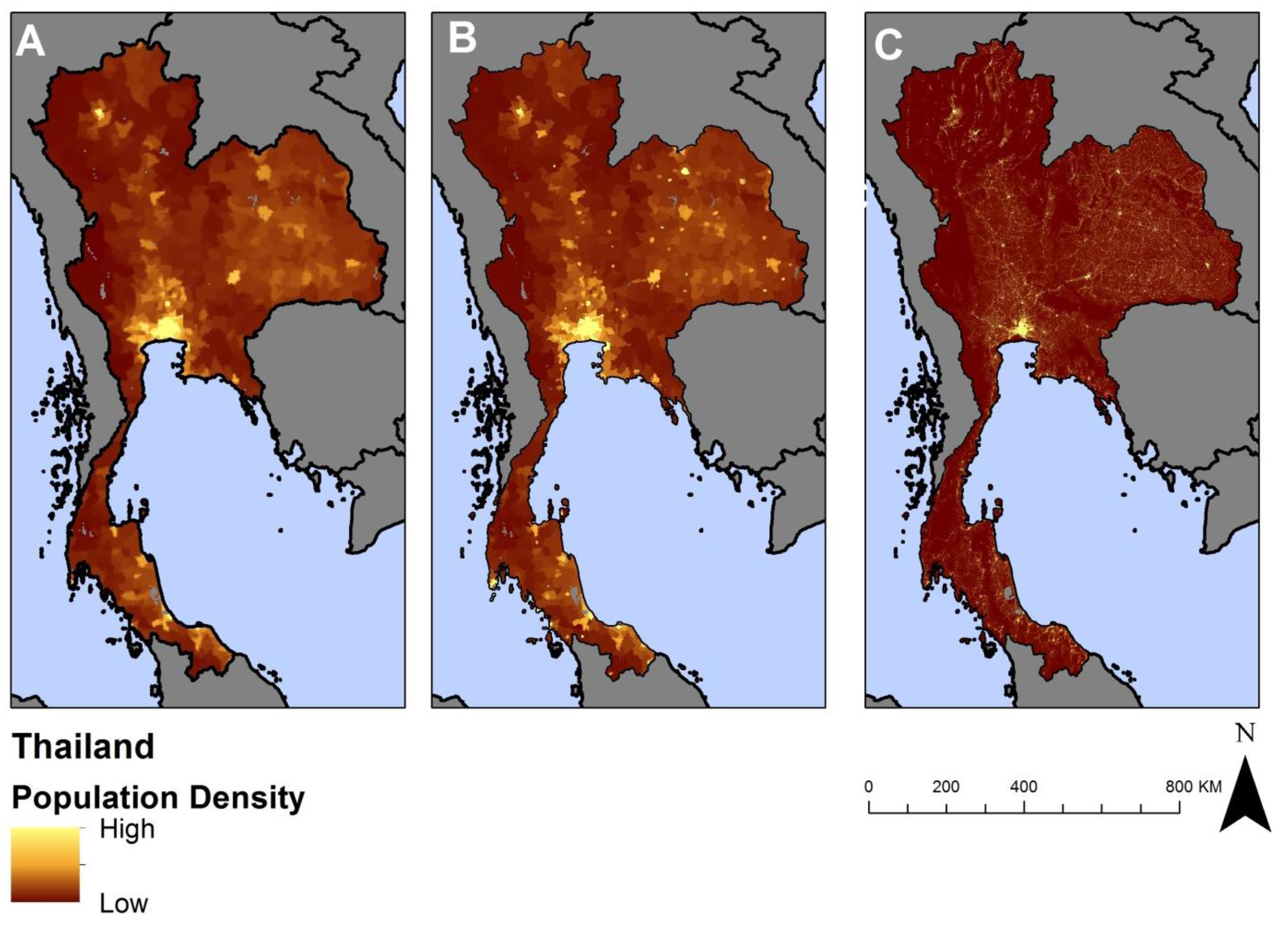
2.3. Climate-Related Hazard Events
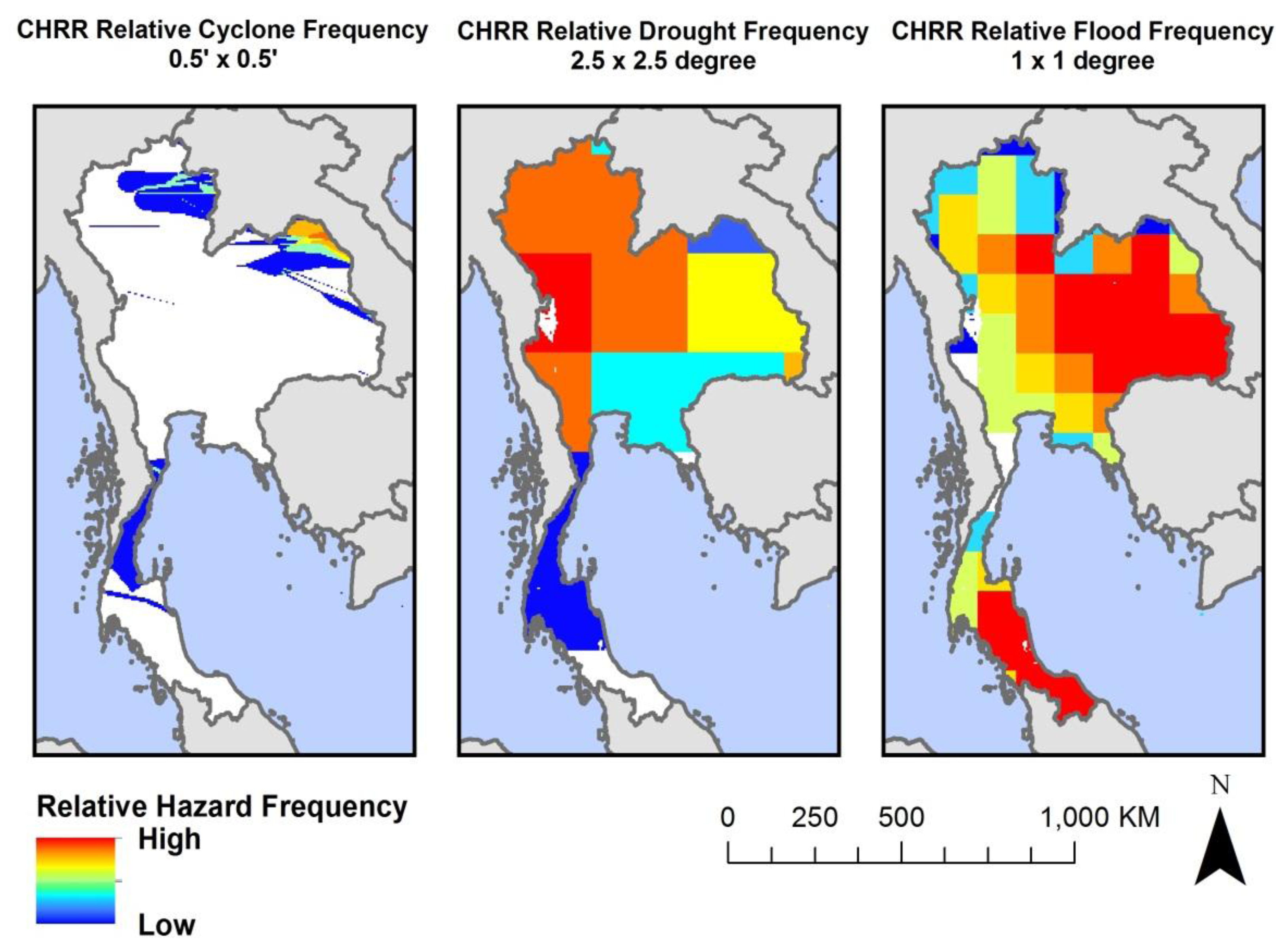
| Data Type | Data Source | Units | Spatial Resolution | Time Period | Description |
|---|---|---|---|---|---|
| Relative Cyclone Frequency | CHRR | Frequency | 0.5' × 0.5'(~1 × 1 km) 1,600 events | 1980–2000 | UNEP/GRID—Geneva PreView uses Saffir Simpson Hurricane index determines extent |
| Relative Drought Frequency | CHRR | Frequency | 2.5° × 2.5° (~276 × 276 km) Unspecified number of events | 1980–2000 | IRI Climate Data Library uses drought defined by WASP |
| Relative Flood Frequency | CHRR | Frequency | 1° × 1° (~111 × 111 km) 3,700 events | 1985–2003 | Dartmouth Flood Observatory uses satellite imagery to determine extent of extreme flood events |
2.4. Calculating Average Exposure of Urban and Rural Populations
2.5. Calculating Population Exposure

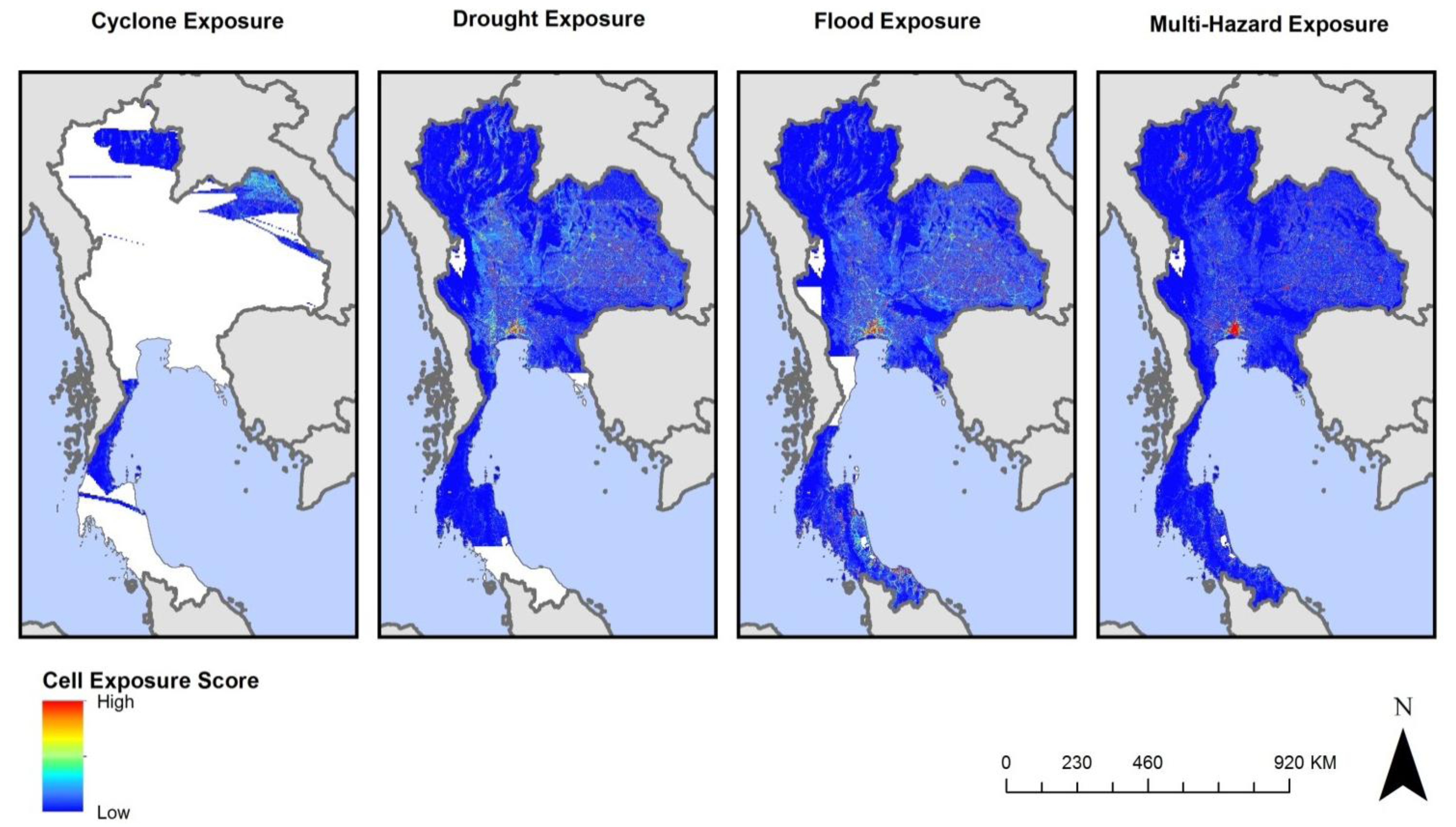



2.6. Automated Model Development
3. Results and Discussion
3.1. Cyclone Country-level Population Exposure
| HDI | Global | Very High | High | Medium | Low |
|---|---|---|---|---|---|
| Cyclone | 0.12 | 0.21 | 0.02 | 0.14 | 0.05 |
| Urban Cyclone | 0.15 | 0.22 | 0.02 | 0.19 | 0.04 |
| Rural Cyclone | 0.09 | 0.13 | 0.02 | 0.1 | 0.05 |
| Drought | 0.37 | 0.14 | 0.27 | 0.46 | 0.5 |
| Urban Drought | 0.32 | 0.14 | 0.27 | 0.43 | 0.53 |
| Rural Drought | 0.43 | 0.11 | 0.27 | 0.49 | 0.47 |
| Flood | 0.51 | 0.48 | 0.4 | 0.57 | 0.47 |
| Urban Flood | 0.51 | 0.49 | 0.41 | 0.59 | 0.48 |
| Rural Flood | 0.5 | 0.42 | 0.36 | 0.55 | 0.47 |
| Multi-Hazard | 1 | 0.82 | 0.68 | 1.17 | 1.02 |
| Urban Multi-Hazard | 0.98 | 0.86 | 0.69 | 1.21 | 1.05 |
| Rural Multi-Hazard | 1.02 | 0.66 | 0.65 | 1.14 | 0.99 |

| Country | Cyclone Rank | Country | Drought Rank | Country | Flood Rank |
|---|---|---|---|---|---|
| Guam | 1 | Gibraltar | 1 | Macao | 1 |
| Northern Mariana Islands | 2 | Lebanon | 2 | Bangladesh | 2 |
| Réunion | 3 | Malta | 2 | Hong Kong | 3 |
| Mauritius | 4 | Nauru | 2 | Jamaica | 4 |
| Hong Kong | 5 | Swaziland | 2 | Guatemala | 5 |
| New Caledonia | 6 | Saint Kitts and Nevis | 6 | Nepal | 6 |
| Japan | 7 | Djibouti | 7 | Liechtenstein | 7 |
| British Virgin Islands | 8 | Jordan | 8 | Singapore | 7 |
| Antigua and Barbuda | 9 | Myanmar | 9 | El Salvador | 9 |
| Macao | 10 | Guatemala | 10 | Honduras | 10 |
| Philippines | 11 | Syria | 11 | Sri Lanka | 11 |
| Madagascar | 12 | Zimbabwe | 12 | Vietnam | 12 |
| United States Virgin Islands | 13 | Eritrea | 13 | Haiti | 13 |
| Puerto Rico | 14 | Pakistan | 14 | Cambodia | 14 |
| Montserrat | 15 | Somalia | 15 | South Korea | 15 |
| Anguilla | 16 | Lesotho | 16 | Colombia | 16 |
| Guadeloupe | 17 | Iraq | 17 | Ecuador | 17 |
| Vanuatu | 18 | Chile | 18 | Kenya | 18 |
| Dominica | 19 | Kiribati | 19 | Rwanda | 19 |
| Saint Kitts and Nevis | 20 | Malawi | 20 | Thailand | 20 |
3.2. Drought Country-level Population Exposure

3.3. Flood Country-level Population Exposure

3.4. Total Country-level Population Exposure: Multi-hazard
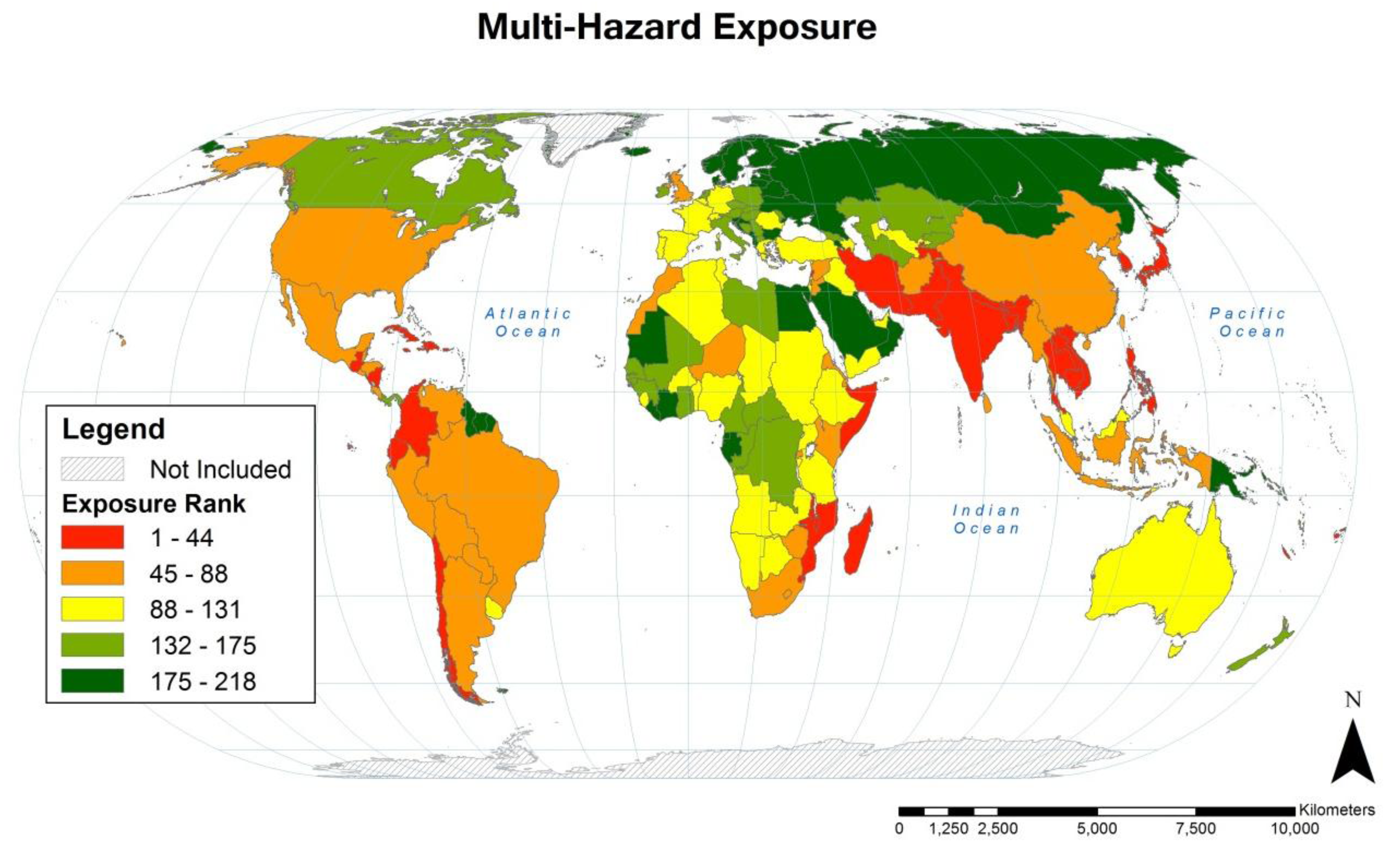
| Country | Cyclone Rank | Drought Rank | Flood Rank | Multi-Hazard Exposure Rank |
|---|---|---|---|---|
| Hong Kong | 5 | 139 | 3 | 1 |
| Philippines | 11 | 74 | 22 | 2 |
| Macao | 10 | 132 | 1 | 3 |
| Guatemala | 63 | 10 | 5 | 4 |
| South Korea | 22 | 118 | 15 | 5 |
| Bangladesh | 53 | 29 | 2 | 6 |
| Vietnam | 36 | 80 | 12 | 7 |
| Saint Kitts and Nevis | 20 | 6 | 181 | 8 |
| Guadeloupe | 17 | 65 | 83 | 9 |
| Guam | 1 | 68 | 132 | 10 |
| Lebanon | 93 | 2 | 42 | 11 |
| Ecuador | 93 | 27 | 17 | 12 |
| Nepal | 93 | 44 | 6 | 13 |
| Japan | 7 | 182 | 64 | 14 |
| British Virgin Islands | 8 | 45 | 181 | 15 |
| Thailand | 73 | 35 | 20 | 16 |
| Puerto Rico | 14 | 193 | 48 | 17 |
| Antigua and Barbuda | 9 | 70 | 134 | 18 |
| New Caledonia | 6 | 66 | 166 | 19 |
| Mozambique | 40 | 31 | 73 | 20 |
3.5. Urban/Rural Population Exposure
3.6. Limitations
4. Conclusions
Supplementary Files
Acknowledgments
Author Contributions
Conflicts of Interest
References
- IPCC Climate Change 2007. In Contribution of Working Groups I, II and III to the Fourth Assessment Report of the Intergovernmental Panel on Climate Change; Pachauri, R.K.; Reisinger, A. (Eds.) Core Writing Team: Geneva, Switzerland, 2007; p. 104.
- Mosquera-Machado, S.; Dilley, M. A comparison of selected global disaster risk assessment results. Nat. Hazards 2009, 48, 439–456. [Google Scholar] [CrossRef]
- UNDP Reducing Disaster Risk: A Challenge for Development. United Nations Development Programme: New York, NY, USA, 2004; pp. 137–146.
- Dilley, M.; Chen, R.S.; Deichmann, U.; Lerner-Lam, A.L.; Arnold, M.; Agwe, J.; Buys, P.; Kjekstad, O.; Lyon, B.; Yetman, G. Natural Disaster Hotspots A Global Risk Analysis; the International Bank for Reconstruction and Development, the World Bank and Columbia University: Washington, DC, USA, 2005. [Google Scholar]
- Global Assessment Report on Disaster Risk Reduction; United Nations International Strategy for Disaster Reduction (UNISDR): Geneva, Switzerland, 2009.
- Global Assessment Report on Disaster Risk Reduction; United Nations International Strategy for Disaster Reduction (UNISDR): Geneva, Switzerland, 2011.
- Global Assessment Report on Disaster Risk Reduction; United Nations International Strategy for Disaster Reduction (UNISDR): Geneva, Switzerland, 2013.
- Cutter, S.L.; Boruff, B.J.; Shirley, W.L. Social vulnerability to environmental hazards. Soc. Sci. Quart. 2003, 84, 242–261. [Google Scholar] [CrossRef]
- Ruel, M.T.; Garrett, J.L.; Hawkes, C.; Cohen, M.J. The food, fuel, and financial crises affect the urban and rural poor disproportionately: A review of the evidence. J. Nutr. 2010, 140, 170–176. [Google Scholar] [CrossRef]
- Baud, I.; Sridharan, N.; Pfeffer, K. Mapping urban poverty for local governance in an indian mega-city: The case of Delhi. Urban Studies 2008, 45, 1385–1412. [Google Scholar] [CrossRef]
- Bright, E.A.; Coleman, P.R.; King, A.L.; Rose, A.N.; Urban, M.L. LandScan 2008; Oak Ridge National Laboratory: Oak Ridge, TN, USA, 2009. [Google Scholar]
- Center for Hazards and Risks Research (CHRR); Columbia University Center for International Earth Science Information Network (CIESIN); Columbia University and International Research Institute for Climate and Society (IRI); Columbia University. Global Cyclone Hazard Frequency and Distribution. 2005. Available online: http://www.ldeo.columbia.edu/chrr/research/hotspots/coredata.html (accessed on 30 March 2012).
- Center for Hazards and Risks Research (CHRR); Columbia University Center for International Earth Science Information Network (CIESIN); Columbia University and International Research Institute for Climate and Society (IRI); Columbia University. Global Drought Hazard Frequency and Distribution. 2005. Available online: http://www.ldeo.columbia.edu/chrr/research/hotspots/coredata.html (accessed on 30 March 2012).
- Center for Hazards and Risks Research (CHRR); Columbia University Center for International Earth Science Information Network (CIESIN); Columbia University and International Research Institute for Climate and Society (IRI); Columbia University. Global Flood Hazard Frequency and Distribution. 2005. Available online: http://www.ldeo.columbia.edu/chrr/research/hotspots/coredata.html (accessed on 30 March 2012).
- World Urbanization Prospects The 2011 Revision; United Nations Department of Economic and Social Affairs Population Division: New York, NY, USA, 2012; p. 18.
- Center for International Earth Science Information Network—CIESIN—Columbia University; Centro Internacional de Agricultura Tropical—CIAT. Gridded Population of the World, Version 3 (GPWv3): Population Density Grid. NASA Socioeconomic Data and Applications Center (SEDAC): Palisades, NY, USA. Available online: http://sedac.ciesin.columbia.edu/data/set/gpw-v3-population-density (accessed 30 March 2012).
- Center for International Earth Science Information Network—CIESIN—Columbia University; International Food Policy Research Institute—IFPRI; The World Bank; Centro Internacional de Agricultura Tropical—CIAT. Global Rural-Urban Mapping Project, Version 1 (GRUMPv1): Urban Extents Grid. NASA Socioeconomic Data and Applications Center (SEDAC): Palisades, NY, USA, 2011. Available online: http://sedac.ciesin.columbia.edu/data/set/grump-v1-urban-extents (accessed 30 March 2012).
- Balk, D.; Yetman, G. The Global Distribution of Population: Evaluating the Gains in Resolution Refinement. Available online: http://sedac.ciesin.org/gpw/docs/gpw3_documentation_final.pdf (accessed 17 February 2014).
- Balk, D.; Pozzi, F.; Yetman, G.; Deichmann, U.; Nelson, A. The distribution of people and the dimension of place: Methodologies to improve the global estimation of urban extents. In Proceedings of the Urban Remote Sensing Conference, Bruge, Belgium, 19–22 September 2005; International Society for Photogrammetry and Remote Sensing: Tempe, AZ, USA, 2005. [Google Scholar]
- Dobson, J.E.; Bright, E.A.; Coleman, P.R.; Durfee, R.C.; Worley, B.A. LandScan: A global population database for estimating populations at risk. Photogramm. Eng. Remote Sensing 2000, 66, 849–857. [Google Scholar]
- Tatem, A.J.; Campiz, N.; Gething, P.W.; Snow, R.W.; Linard, C. The effects of spatial population dataset choice on estimates of population at risk of disease. Popul. Health Metr. 2011, 9. [Google Scholar] [CrossRef]
- Galway, L.; Bell, N.; Sae, A.S.; Hagopian, A.; Burnham, G.; Flaxman, A.; Weiss, W.M.; Rajaratnam, J.; Takaro, T.K. A two-stage cluster sampling method using gridded population data, a GIS, and Google Earth(TM) imagery in a population-based mortality survey in Iraq. Int. J. Health Geogr. 2012, 11. [Google Scholar] [CrossRef]
- Mondal, P.; Tatem, A.J. Uncertainties in measuring populations potentially impacted by sea level rise and coastal flooding. PLoS One 2012, 7. [Google Scholar] [CrossRef]
- Huggel, C.; Clague, J.J.; Korup, O. Is climate change responsible for changing landslide activity in high mountains? Earth Surf. Process. Landf. 2012, 37, 77–91. [Google Scholar] [CrossRef]
- Borgatti, L.; Soldati, M. Landslides as a geomorphological proxy for climate change: A record from the Dolomites (northern Italy). Geomorphology 2010, 120, 56–64. [Google Scholar] [CrossRef]
- Dehn, M.; Bürger, G.; Buma, J.; Gasparetto, P. Impact of climate change on slope stability using expanded downscaling. Eng. Geol. 2000, 55, 193–204. [Google Scholar] [CrossRef]
- Buma, J.; Dehn, M. A method for predicting the impact of climate change on slope stability. Environ. Geol. 1998, 35, 190–196. [Google Scholar] [CrossRef]
- Crozier, M.J. Deciphering the effect of climate change on landslide activity: A review. Geomorphology 2010, 124, 260–267. [Google Scholar] [CrossRef]
- Potere, D.; Schneider, A.; Angel, S.; Civco, L. Mapping urban areas on a global scale : Which of the eight maps now available is more accurate? Int. J. Remote Sens. 2009, 30, 6531–6558. [Google Scholar] [CrossRef]
- Schneider, A.; Friedl, M.A.; Potere, D. A new map of global urban extent from MODIS satellite data. Environ. Res. Lett. 2009, 4. [Google Scholar] [CrossRef]
- Bicheron, P.; Defourny, P.; Brockmann, C.; Schouten, L.; Vancutsem, C.; Huc, M.; Bontemps, S.; Leroy, M.; Achard, F.; Herold, M.; et al. 2008 GLOBCOVER: Products Description and Validation Report; European Space Agency (ESA): Toulouse, France, 2008. [Google Scholar]
- Elvidge, C.D.; Tuttle, B.T.; Sutton, P.C.; Baugh, K.E.; Howard, A.T.; Milesi, C.; Bhaduri, B.; Nemani, R. Global distribution and density of constructed impervious surfaces. Sensors 2007, 7, 1962–1979. [Google Scholar] [CrossRef]
- Elvidge, C.D.; Imhoff, M.L.; Baugh, K.E.; Hobson, V.R.; Nelson, I.; Safran, J.; Dietz, J.B.; Tuttle, B.T. Night-time lights of the world: 1994–1995. ISPRS J. Photogramm. 2001, 56, 81–99. [Google Scholar] [CrossRef]
- Goldewijk, K.K. Estimating global land use change over the past 300 years: The HYDE Database. Glob. Biogeochem. Cycles 2001, 15, 417–433. [Google Scholar] [CrossRef]
- Panel on Urban Population Dynamics Urban Population Dynamics. In Cities Transformed: Demographic Change and Its Implications in the Developing World; Montgomery, M.R.; Sren, R.; Cohen, B.; Reed, H.E. (Eds.) The National Academies Press: Washington, DC, USA, 2003; pp. 108–154.
- Salvatore, M.; Pozzi, F.; Ataman, E.; Huddleston, B.; Bloise, M. Mapping Global Urban and Rural Population Distributions; Food and Agriculture Organization of the United Nations: Rome, Italy, 2005; Volume 12. [Google Scholar]
- ArcGIS Desktop: Release 10; Environmental Systems Research Institute: Redlands, CA, USA, 2011.
- Bollinger, D. Unload Table to Text Extension for ESRI. ArcGIS Desktop 2009. Available online: http://arcscripts.esri.com/details.asp?dbid=13692 (accessed on 15 June 2013).
- The Water Institute, Gillings School of Global Public Health, University of North Carolina, Chapel Hill, NC, USA. Available online: http://waterinstitute.unc.edu (accessed on 17 February 2014).
- Human Development Report 2013: The Rise of the South: Human Progress in a Diverse World; United Nations Development Programme: New York, NY, USA, 2013; p. 203.
- Knowledge Base. In The United Nations World Water Development Report 4: Managing Water under Uncertainty and Risk; World Water Assessment Programme (WWAP): Paris, France, 2012; pp. 381–779. Volume 2.
- The AfriPop Project. Available online: http://www.afripop.org/ (accessed on 1 March 2013).
- Tatem, A.; Linard, C. Population mapping of poor countries. 2011, 474. [Google Scholar] [CrossRef]
- USAID Republic of the Marshall Islands Drought Fact Sheet #1. 2013. Available online: http://www.usaid.gov/sites/default/files/documents/1866/05.16.13%20-%20USAID-DCHA%20Republic%20of%20the%20Marshall%20Islands%20Drought%20Fact%20Sheet%20_1.pdf (accessed on 26 July 2013).
- Pope, T. Marshall Islands Bracing for More Destructive Seas. Australia Network News 2013. [Google Scholar]
© 2014 by the authors; licensee MDPI, Basel, Switzerland. This article is an open access article distributed under the terms and conditions of the Creative Commons Attribution license (http://creativecommons.org/licenses/by/3.0/).
Share and Cite
Christenson, E.; Elliott, M.; Banerjee, O.; Hamrick, L.; Bartram, J. Climate-Related Hazards: A Method for Global Assessment of Urban and Rural Population Exposure to Cyclones, Droughts, and Floods. Int. J. Environ. Res. Public Health 2014, 11, 2169-2192. https://doi.org/10.3390/ijerph110202169
Christenson E, Elliott M, Banerjee O, Hamrick L, Bartram J. Climate-Related Hazards: A Method for Global Assessment of Urban and Rural Population Exposure to Cyclones, Droughts, and Floods. International Journal of Environmental Research and Public Health. 2014; 11(2):2169-2192. https://doi.org/10.3390/ijerph110202169
Chicago/Turabian StyleChristenson, Elizabeth, Mark Elliott, Ovik Banerjee, Laura Hamrick, and Jamie Bartram. 2014. "Climate-Related Hazards: A Method for Global Assessment of Urban and Rural Population Exposure to Cyclones, Droughts, and Floods" International Journal of Environmental Research and Public Health 11, no. 2: 2169-2192. https://doi.org/10.3390/ijerph110202169




